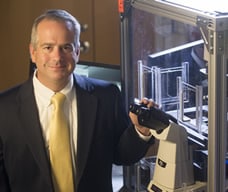Doctor John McLean
Big Data BiologyAgilent helps researchers quickly gather vast array of detailsJohn McLean is part of a paradigm shift in biology. Call it big data biology. Dr. McLean and his team at Vanderbilt are using Agilent’s 6560 Ion Mobility Q-TOF LC/MS system to gather details of 50,000 molecules a minute in untargeted experiments. Details about proteins, lipids, sugars, peptides—it’s all in there. McLean describes his team’s approach as integrated omics, and he sees it as the only way to do what they want to do. They want to uncover hidden patterns in how the diverse components of biology interact—patterns that could, for example, reveal the makings of promising new drug candidates within bacteria found in caves in Tennessee (Vanderbilt’s home state). “We’re breaking the old paradigm of individual omics studies—genomics, proteomics, and so on—and taking a truly untargeted, unbiased survey of the molecular inventory, using ion mobility coupled with mass spectrometry,” McLean says
The technology in the Agilent 6560 ion mobility system enables scientists to capture a vast array of details very quickly.
“We’re now able to go into a biological question with or without having a target in mind,” McLean says. “We can let the analysis tell us what we should be paying attention to.” Gleaning insights from big data is, well, a big challenge. But that’s where McLean and his team excel. They use the same sort of techniques that companies like Amazon and Netflix use to sift through the accumulated actions of millions of users to recommend books and movies that you might like: They harness their computer farms to look at the numbers and find meaningful correlations. McLean compares the process to the sliding-tile puzzles you may have played with as a child. “We do the same thing,” he says. “When we get 50,000 molecules every minute off the 6560, we make no attempt to identify those until we start creating these tiles and shifting them around to form a picture. Of those 50,000 molecules, many are just noise—just background biology. What we want to know is: What are the correlations arising from molecules that are directly affected by the drug or other stimulus? Then we spend our time identifying what those are.” The correlations become the tiles and then the fun begins. “All this big data stuff, it’s all the same game,” McLean says. “What are the patterns? Once you remove the descriptors from the data, it’s just a huge series of numbers. Then it depends on who’s looking at the numbers and knows what generated them. It doesn’t matter if you’re in Internet commerce or trying to solve biology. It’s all the same thing.”
McLean is leading a number of research projects at Vanderbilt, involving disease diagnoses, drug discovery, and the search for biomarkers that could indicate the onset of trouble even before symptoms arise.
One of the more fruitful projects is something the team calls Bacteria Fight Club. It started from the simple fact that one of McLean’s collaborators is a spelunker and enzymatic enzymologist. “In Tennessee and Kentucky, there are 10,000 caves, so he goes and collects bacteria that have never seen humans before,” McLean explains. “When we do the genetic analysis, we can see there are particular gene clusters that should encode for drug-like molecules—natural offensive and defensive biological agents—that we’ve never seen before. However, it’s difficult to figure out how to get the bacteria to actually synthesize it, so we play this game we call Bacteria Fight Club. We grow the new-found bacteria as a monoculture, then we grow bacteria we know a lot about—E. coli, for example—and finally we co-culture them. Now both strains of bacteria have to fight for limited resources. All of a sudden, they turn on a lot of those genes that are hard to get them to turn on. We’ve been able to isolate many new drug molecules that way.” “Now you can start to do the arithmetic. If you have the tile picture for the cell culture, you can now subtract the tile pictures from the monocultures. Now you’re left with only those new molecules that the organisms are generating when they have to fight for resources,” McLean says. “Usually drugs are hybrids of different classes of molecules, so you’re never dealing just with lipids or sugars or peptides. You’re looking at a mixture of those different classes making a good drug molecule. So integrated omics is vital. You couldn’t do it any other way.” For Research Use Only. Not for use in diagnostic procedures.
|

John A. McLean, Ph.D.
Department of Chemistry |